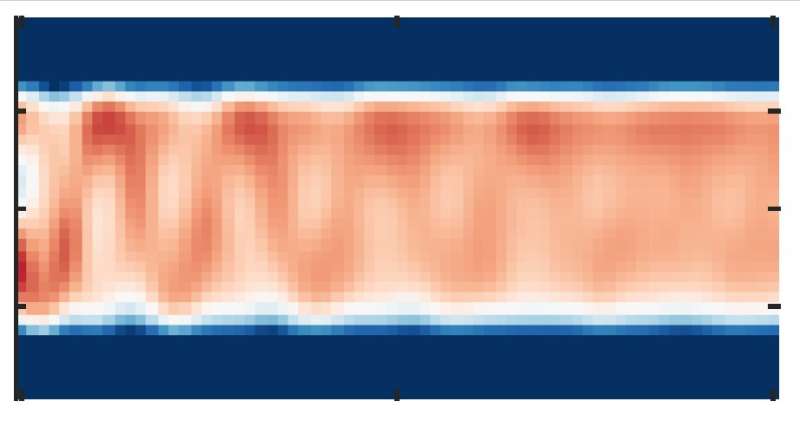July 17, 2020 feature
Probing the properties of a 2-D fermi gas

When a new physical system is created or uncovered, researchers generally study it in depth to unveil its distinctive properties and characteristics. For example, they might try to determine how the system reacts when it is disturbed, and in what ways this disturbance typically propagates through it.
To explain this in simpler terms, a researcher might investigate how different fluids (e.g., water, oil, or honey) respond when a stone is thrown into them. In these cases, throwing a stone would typically lead to the formation of waves, which would then dampen at varying rates/speeds, depending on the viscosity of the fluid in question.
A similar case is that of density excitations in gasses. These are essentially density increases that propagate through a gas in the form of sound waves.
Researchers at the University of Hamburg and Heidelberg University in Germany have recently carried out a study aimed at uncovering the thermodynamic and transport properties of a 2-D Fermi gas by examining how sound waves propagate and dampen in it. Their paper, published in Physical Review Letters, shows that the system they created and examined is a near-perfect model system to investigate the physics of strong correlations in reduced dimensions.
"Our experiment is among the few worldwide in which ultracold 2-D Fermi gasses are produced and investigated," Markus Bohlen, one of the researchers who carried out the study, told Phys.org. "These systems are captivating: The interplay of strong interactions and reduced dimensionality leads to fascinating phenomena, but also complicates theoretical approaches. Here, quantum gas experiments provide valuable insights and enable studying these systems in a clean and controlled environment."
In their experiments, Bohlen and his colleagues set out to measure the speed of sound and sound attenuation in a ultracold 2-D Fermi gas, as this would in turn allow them to probe its excitation properties. To do this, they specifically focused on the propagation and damping of sound waves in the gas.
"Sound waves are oscillations in density, temperature, pressure, as well as other thermodynamic variables," Bohlen explained. "These variables are not independent, but rather related to each other via a so-called equation of state. The equation of state determines the thermodynamic behavior of the system, e.g., how much denser or hotter does a gas get when it is compressed?"
In their study, Bohlen and his colleagues extracted the 2-D Fermi gas' compressibility equation of state from the speed of sound waves propagating inside it. Physics theory suggests that the faster waves travel inside a system, the stiffer the system must be (i.e., the lower its compressibility must be).
"A system that is excited out of equilibrium will eventually relax back to its equilibrium state," Bohlen said. "In a strongly interacting gas, the rate of relaxation is determined by the viscosity of the gas and the heat conductivity. These so-called transport coefficients describe how fast differences in velocity or temperature are equilibrated through the medium. By measuring the damping rate of sound in our gas, we can therefore infer information about these transport coefficients."
The measurements collected by the researchers led to a number of interesting observations. First, Bohlen and his colleagues observed that in the 2-D Fermi gas, sound waves were damped the least at the regime in which atoms interacted more strongly. These findings can seem counterintuitive, as one might expect that collisions between particles would reduce the waves' motion. Contrarily, this only occurs in cases where there are relatively few collisions.
If the interactions between particles are very strong, however, like in the researchers' experiment, the situation drastically changes. This is because frequent collisions between particles actually prevent the dispersion of energy and thus inhibit dissipation rather than increasing it.
"In the regime we focused on, the transport coefficients tend towards a limit determined by quantum mechanics, which has been conjectured in the context of quantum field theories and observed for different transport coefficients in various systems," Bohlen said. "We could confirm that this limit is obeyed in the case of sound diffusion in 2-D Fermi gasses."
These findings shed some light on how sound waves propagate and subside inside an ultracold 2-D Fermi gas, thus unveiling some of its thermodynamic and transport properties. In the future, the gas examined in their paper could be used to test the validity of physics theories and models related to strongly interacting Fermi gasses. Meanwhile, Bohlen and his colleagues plan to conduct new studies investigating superfluidity in the same 2-D Fermi gas examined in their recent paper.
"Superfluidity (and superconductivity) is closely related to the existence of so-called long-range order," Bohlen explained. "In 2-D geometries, such long-range order is prohibited, yet it seems that for all materials showing superconductivity at high temperatures, 2-D structures play a crucial role. We have recently shown that our 2-D system is, indeed, a superfluid, and we would like to shed light onto the role of dimensionality for the robustness of superfluidity."
More information: Markus Bohlen et al. Sound Propagation and Quantum-Limited Damping in a Two-Dimensional Fermi Gas, Physical Review Letters (2020). DOI: 10.1103/PhysRevLett.124.240403
Journal information: Physical Review Letters
© 2020 Science X Network




















